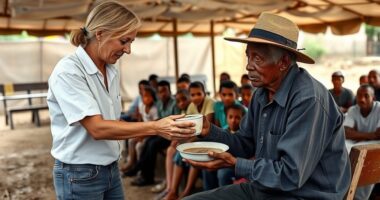In a post-pandemic world, you should prioritize safety, cultural sensitivity, and flexibility when planning mission trips. Respect local customs, partner with community leaders, and stay updated on health guidelines to build trust. Be ready to adapt plans as needed, communicate openly, and focus on community well-being over rigid expectations. By embracing these best practices, you’ll foster meaningful connections. Keep exploring to discover more strategies that guarantee your trip is impactful and respectful.
Key Takeaways
- Prioritize community needs and involve local leaders to ensure culturally sensitive and relevant project activities.
- Implement strict health protocols, including vaccination, testing, mask-wearing, and hygiene measures for all team members.
- Maintain flexibility in planning to adapt activities based on changing health guidelines and local circumstances.
- Build trust through respectful engagement, active listening, and understanding of local customs and traditions.
- Prepare comprehensive safety plans, including emergency procedures and local healthcare resources, to ensure team and community safety.

As communities and organizations resume mission trips after the pandemic, it’s crucial to adopt best practices that prioritize safety, flexibility, and cultural sensitivity. You need to approach each trip with a clear understanding of the local culture and customs. Cultural sensitivity isn’t just about avoiding faux pas; it’s about respecting the community’s traditions, values, and social norms. Before you go, take time to research and learn about the community’s history, language, and everyday practices. Engage with local leaders or partners to gain insights into appropriate behaviors and communication styles. Showing genuine respect and understanding helps build trust, making your efforts more meaningful and effective.
In addition, implementing thorough safety protocols is essential. The pandemic has heightened awareness around health risks, so ensure your team is well-versed in current health guidelines. This includes COVID-19 testing, vaccination requirements, and mask mandates if applicable. Encourage good hygiene practices, such as frequent handwashing and the use of hand sanitizers. Be prepared with a basic medical kit, and know where local healthcare facilities are located in case of emergencies. It’s also wise to establish clear safety procedures for different scenarios—whether it’s a medical emergency, natural disaster, or security concern. Regular check-ins and maintaining open communication channels help keep everyone informed and safe throughout the trip. Developing your Cultural Intelligence can further enhance your understanding of local contexts and improve your interactions with community members.
Flexibility is another critical component. The post-pandemic landscape is unpredictable; plans may need to change unexpectedly. You should be prepared to adapt your schedule, activities, or even the scope of your work based on local health advisories or logistical challenges. Building flexibility into your plans demonstrates respect for the community’s current circumstances and shows that you’re prioritizing their well-being above rigid expectations. It also helps your team stay resilient and positive despite unforeseen obstacles. Listen actively to local partners and community members—they often have invaluable insights about what’s feasible and safe at any given moment.
Frequently Asked Questions
How Can We Ensure Safety During International Travel?
To guarantee safety during international travel, you should always prioritize travel insurance that covers health emergencies and cancellations. Follow all health protocols, including wearing masks, sanitizing your hands frequently, and maintaining social distancing. Stay updated on local health guidelines, and communicate regularly with your team. By preparing thoroughly and staying vigilant, you can minimize risks and enjoy your trip securely and responsibly.
What Are Cost-Effective Ways to Organize Local Mission Trips?
To organize cost-effective local mission trips, focus on fun, focused fundraising strategies like bake sales or sponsorships, which boost budget boosts. Recruit volunteers through social media, community boards, and word-of-mouth, saving on recruitment costs. Leverage local resources, partner with community organizations, and use existing facilities to minimize expenses. By blending budgeting brilliance with volunteer energy, you can maximize impact without stretching your dollars too thin.
How Do We Measure the Impact of Post-Pandemic Mission Work?
You measure the impact of post-pandemic mission work by tracking community engagement and evaluating long-term sustainability. You can do this through surveys, interviews, and observing ongoing local initiatives. Regularly gather feedback from community members and partners to understand how your efforts foster resilience and growth. Focus on tangible outcomes like improved infrastructure or skills development, ensuring your work supports lasting change rather than short-term fixes.
What Training Is Recommended for Volunteers in a New Normal?
You should prioritize cultural sensitivity and health protocols training for volunteers, because these are essential in the new normal. You might think this slows things down, but it actually readies your team better. Conduct workshops on local customs, communication, and safety measures. This ensures volunteers respect local cultures, follow health guidelines, and stay safe while making a meaningful impact in the communities you serve.
How Can Technology Enhance Mission Trip Preparations and Execution?
You can leverage technology to enhance mission trip preparations and execution through virtual collaboration, allowing team members to coordinate efficiently regardless of location. Additionally, digital fundraising tools make it easier to gather support and resources beforehand. By embracing these technologies, you streamline planning, improve communication, and boost engagement, ensuring your mission trip runs smoothly and effectively in the post-pandemic world.
Conclusion
As you plan your mission trips in a post-pandemic world, remember that adapting best practices guarantees safety and effectiveness. Think of it like building a sturdy bridge—you need strong, reliable materials and clear design. By prioritizing health protocols, cultural sensitivity, and collaboration, you create a safe environment for everyone involved. Investigate these principles thoroughly, and you’ll visualize a successful, impactful mission that truly benefits both your team and the communities you serve.









